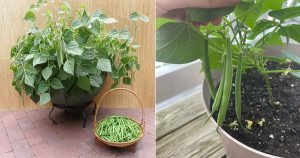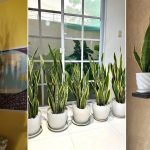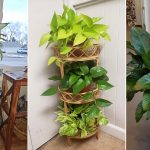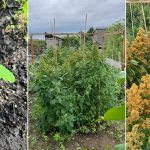Onions make almost anything taste better, but they do leave that pesky bad breath in their wake. Unfortunately, I don’t have a remedy for onion breath. But I do know how to grow onions in containers. It’s pretty easy, you should definitely give it a try. Just keep a lot of gum or mints with you when you’re taste testing.
What Kind of Containers Are Best
A long planter box that is at least 10 inches deep, 15 inches wide, and as long as your space will accommodate is your best bet. You don’t necessarily need to use a container originally meant for planting. An opaque plastic tub meant for organizing your closet will work just fine. Just be sure that you drill or punch holes in the bottom and raise the container up off the ground with pot feet or bricks.
Choosing The Right Kind of Plant
Seeds are the cheapest but take the longest to grow. Small onion plants are called “sets” and are a great compromise between cost and length of time until your breath is tinged with the smell of homegrown onions. Transplants will cost more (but still very reasonable) and will allow you to grow the largest onion. Onions make great companion plants, check out that list to see which vegetables will grow best with them.
Another consideration is “short day” versus “long day.” Basically, onions don’t start growing a bulb until the temperature gets above a certain level and the number of hours of sunlight reaches a certain point. Short day plants need 10-12 hours of sunlight a day while long day onions need 14-16 hours. Northerners should pick long day and Southerners should pick short day varieties. Northern summers have looong days, perfect for long day onions, but not so good for the short day kind (too much daylight can cause onions to make their bulbs before they’re ready, resulting in smaller bulbs). Likewise, the comparatively fewer daylight hours during a Southern summer are perfect for short day varieties but not long enough for the long day kinds of onions.
Getting Started
- If you’re starting from seed, sow the seeds 2-3 months before your last frost date. Sow the seeds 1/2 inch deep. In everywhere but the most mild climates, you’ll need to start your seeds indoors as onions will need your entire outdoor growing season to do their thing.
- With sets, it’s best to wait until it’s consistently above 50 F outside before moving them outdoors. Plant them two inches deep and at least four inches apart.
- If you want really big onions, transplants are your best bet. Plant them at least five inches apart.
- Regardless of what stage of onion you start with, use good quality, fast draining potting soil amended with compost. Avoid potting soil that comes with a time-release fertilizer already mixed in.
Caring For Container Grown Onions
Remember that your onions need full sun, which means they need at least 6 hours of direct sunlight. Move them around your balcony if need be to make sure that, as the season progresses, they are still receiving enough sunshine.
Onions also need quite a bit of water. Whenever the top of the soil in their container is dry, it’s time to water. Pour about an inch of the wet stuff into the pot each time you water. In the height of summer, you may find yourself watering every three days. However, don’t over do it. Sopping wet soil all the time could lead your onions to rot.
There is no need to fertilize, and definitely don’t use a high nitrogen fertilizer. Nitrogen encourages leaf-growth at the expense of bulb development.
When the leaves start to yellow and die, it’s time to pull up your onions. However, if you see any flowers, pull the onions immediately, regardless of how the leaves look.
Combating Onion Pests
- If you are not using brand new potting soil, don’t grow onions in the same container where you’ve grown onions or other root vegetables or flowering bulbs before. Insects like bulb mites and onion maggots, that like to eat bulbs and roots are most common in places where those sorts of plants have been grown before.
- If you notice white blotches on your onion leaves, then you’ve probably got some onion thrips visiting your plants. If the party gets too large, your onions will not grow to be as big as they could have been, and if things get really bad, the thrips could kill your plant all together. Combat them with organic insecticide spray at the first sighting. Be sure to get the insecticide into the inner parts of the plants.




